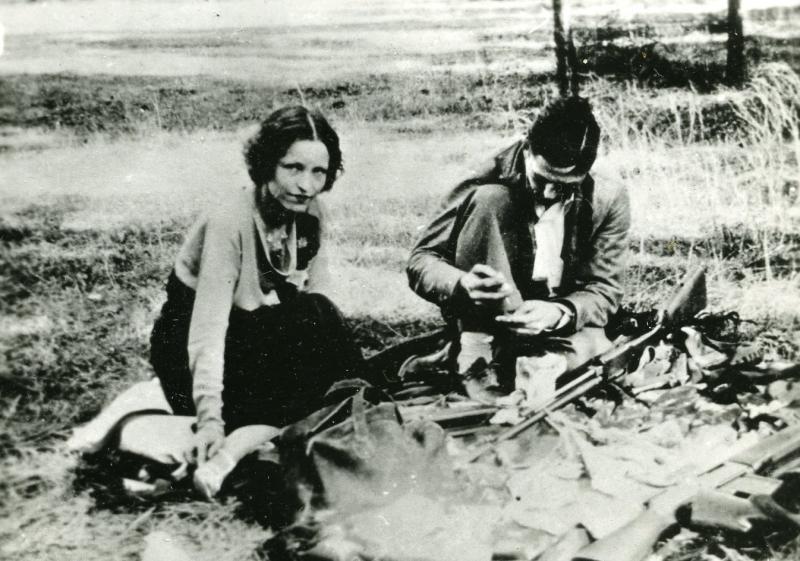
“Bonnie and Clyde have been elevated to a timeless symbol of America itself—an anti-authoritarian, we’ll-do-it-our-way, gun-slinging Romeo and Juliet."
Bonnie and Clyde consistently capture the American imagination across time, demographics and politics. From the counterculture anti-heroes of the 1967 smash hit film to the hidden faces of evil in The Highwaymen in 2019—the outlaw lovers have transcended reality to become symbols able to reflect the latest cultural currents.
Now, a speculative fiction series expands their myth to cast the duo as reluctant defenders of the working class during the Great Depression and beyond.
Pumpjack Press released the third (and final) novel of a three-book series about the outlaw lovers, Bonnie and Clyde: Radioactive by Clark Hays and Kathleen McFall, on the same day as the 85th anniversary of the outlaws’ (alleged) deaths.
“Americans love outlaws, especially when they stand up to authority. And, why wouldn’t we? Our national origins story is about standing up to unjust authority,” said Clark Hays, co-author. “Think of the Boston tea party when Americans tossed British tea into the harbor, a criminal act of defiance against the monarchy. Bonnie and Clyde, initially at least, fit that bill.”
into the harbor, a criminal act of defiance against the monarchy. Bonnie and Clyde, initially at least, fit that bill.”
Clark is a native of Texas, born in Lubbock, and son of wildcat driller Hubert Hays, who spun plenty of tales about the outlaws when Clark was a child. “He once told me that a beat up old abandoned car on our ranch was their getaway car. Those tall tales were part of what sparked my interest in writing about the duo.”
In Hays and McFall’s retelling, Bonnie Parker and Clyde Barrow didn’t die in the bullet-riddled car in 1934. Instead, they were saved at the last minute by a shadowy government agent who needs their “special skills” to protect American democracy from the corrupting power of greed.
The authors cast the outlaws as covert operatives because the historical accounts of their days on the run—they were cunning, creative, fearless, had absolute trust and faith in each other, and were willing to use violence when it suited their needs—fit the classic literary model of the skill set of spies.
“Bonnie and Clyde have been elevated to a timeless symbol of America itself—an anti-authoritarian, we’ll-do-it-our-way, gun-slinging Romeo and Juliet. Although, this symbolism tends to overlook, for the most part, the fact that they were thieves and murderers,” author Kathleen McFall said. “In our story, we face that truth squarely.”
Hays agreed that an important theme of the books is addressing the consequences of their violent crimes. “As they age and are forced to think about their past, Bonnie and Clyde serve as proxies to explore the thorny issues of atonement and forgiveness—questions we as a society also wrestle with in terms of how we design our justice system.”
And that’s not the only thematic element of the story. The books also explore issues related to the current imbalance in the nation’s economic landscape. In the days before and after the Great Depression in the 1930s and ‘40s, wealth inequality approached the current alarming levels in the U.S. By setting the story in this parallel historical economic context, the past is held up to the present as a mirror.
“We see a role today for storytelling to remind readers that during the 1930s and beyond, the government reined in the more destructive aspects of capitalism with innovative policies and worker protections. We want to inspire people across the political, cultural, and economic spectrum to think creatively together to solve our current challenges,” McFall said.
Although the novels are alternative history, the plots are anchored in true events from the era.



In the first book, Resurrection Road, the outlaws race to save President Franklin D. Roosevelt from an assassin trying to scuttle the New Deal—a tale inspired by the real-life attempt anarchist Giuseppe Zangara made on FDR in 1933. The president survived, obviously, but the mayor of Chicago died. In Dam Nation, the second book, Bonnie and Clyde are dispatched to save Hoover Dam—a 1935 federally-funded New Deal project that put thousands of people back to work—from unknown forces trying derail the construction. The plot has roots in historical facts about shady aspects of the dam’s construction kept under wraps for years. In the latest (and last) book—Radioactive—released May 23, 2019, the duo is deep undercover at the Hanford site (in Richland, Washington; part of The Manhattan Project) in 1945, trying to protect atomic secrets from Russian and Nazi nationals during World War II. The book mirrors the actual spying our wartime enemies undertook on American soil in eastern Washington during this pivotal time.
Authors Clark Hays and Kathleen McFall have written seven novels together. Honors include inclusion on Kirkus Reviews Best books of 2014 list, a 2017 IPPY Medal from Independent Publishers of America, an Oregon Literary Arts Fellowship and a Pushkin Prize nomination. Read more at www.pumpjackpress.com
